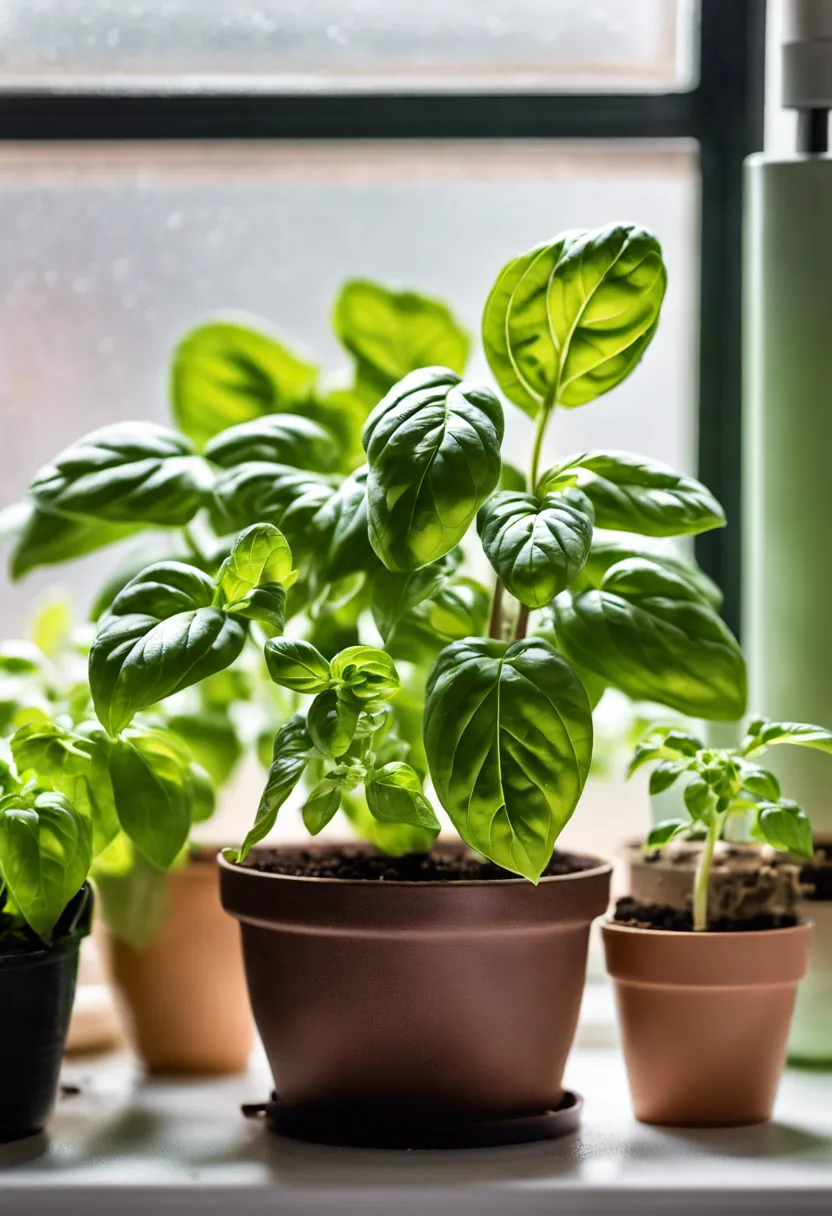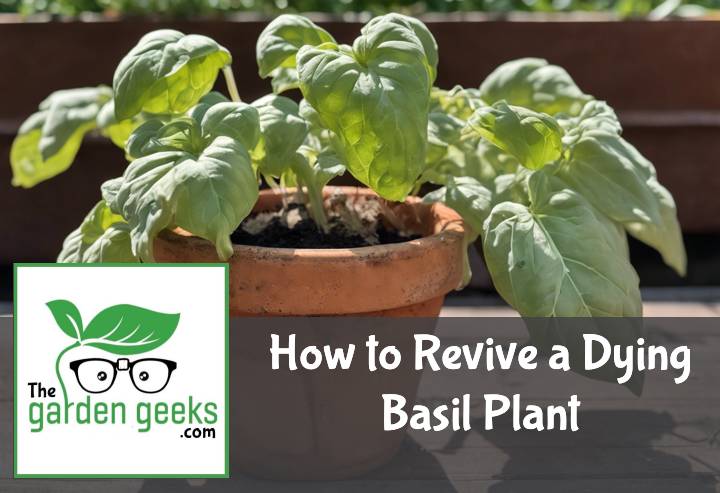Did you know that over 70% of home gardeners have faced the distress of watching their beloved basil plants wither away? That’s right, and the most frustrating part is not knowing How to Revive a Dying Basil Plant.
But don’t lose hope just yet. The good news is, with some tender love and care, your dying basil plant can bounce back to life. Understanding what’s causing the decline is half the battle won.
So let’s dive in, shall we? Keep reading about How to Revive a Dying Basil Plant and learn how you can turn things around for your green buddy!
Quick Answer
- Identify the signs of a dying basil plant, like yellowing leaves or stunted growth.
- Understand the causes of decline, which could be environmental stress, pests and diseases, watering problems, or soil and nutrient deficiencies.
- Apply step by step revival techniques for your basil plant. This could involve adjusting its environment, treating it for pests or diseases, correcting watering issues, or amending the soil.
- Prevent future issues by providing optimal growing conditions and regular maintenance. This includes proper sunlight exposure, appropriate watering schedule and pest control measures.

Identifying the Signs of a Dying Basil Plant
Knowing when your basil is in trouble is key to saving it. Look out for these warning signs.
Visual Symptoms
When your basil looks sad, it’s time to pay attention. Yellowing basil leaves are like a big, flashing sign saying, “Help me!” It means the plant isn’t happy, possibly due to overwatering or not enough light.
Another bad sign is a wilting basil plant. This could mean too much sun or not enough water. It’s like when you feel super thirsty on a hot day.
Seeing brown spots on basil leaves? That’s like the plant version of getting bruises. It can be from fungal infections or too much direct sunlight hitting those tender leaves.
Growth and Development Issues
If your basil is growing slower than a snail, that’s a problem. Stunted growth in basil plants shows something’s off with its environment or care routine.
And if there are no flowers on basil plants, especially when it should be blooming, it’s waving a red flag at you. It might need more sunshine or better soil to thrive.
Lastly, if you’ve got a case of slow-growing herbs, don’t just shrug it off. Your basil could be screaming for nutrients or simply begging for some more room to spread its roots.
Understanding the Causes of Decline
Basil plants can start to look sad for many reasons. It could be bugs, not enough water, or even too much sun!
Environmental Stress Factors
Basil loves the sun but not too much! If it gets too hot, your basil might get stressed out. Think of it like us needing sunscreen on a super sunny day. Basil needs some shade to stay happy.
Sometimes, if basil doesn’t get enough light, it can also feel down. Imagine trying to read in a dim room all day. Basil feels the same way about light; it needs just the right amount to grow strong.
Changing temperatures can make basil unhappy, too. If it’s too cold or suddenly gets hot, basil gets shocked. It’s like when we jump into a cold pool on a hot day – shocking!
Pests and Diseases
Bugs love basil as much as we do! Aphids and spider mites can sneak up and start eating your plant. It’s like having uninvited guests at a party who eat all the snacks.
Fungal diseases are another headache. They sneak up when basil’s leaves stay wet for too long. Imagine wearing wet socks all day; your feet wouldn’t like that, right? Basil feels the same about its leaves.
To keep these pests and diseases away, think of being a plant detective. Check under leaves and make sure your plant isn’t sitting in water.
Watering Problems
Watering your basil is tricky; it’s like Goldilocks not wanting her porridge too hot or too cold but just right. Basil doesn’t like its “feet” wet all the time or to be super thirsty.
Overwatering makes basil roots soggy and sad because they can’t breathe underwater! Underwatering makes them dry and thirsty, wishing for a drink.
The trick is to check if the topsoil feels dry before giving water. Think of it as checking if you need an umbrella before going outside – just in case!
Soil and Nutrient Deficiencies
Basil is picky with its soil; it likes it rich and full of goodies (nutrients). If the soil is more like fast food than a balanced meal, basil won’t be happy.
Nutrient deficiencies make basil look pale and weak, kind of how we feel after eating junk food for days. To fix this, think about feeding your plant some healthy snacks (fertilizer).
Improving soil for basil means making sure it drains well but still holds onto moisture like a sponge – not too wet but not dry either.



Step by Step Revival Techniques for Your Basil Plant


Bringing your basil back from the brink might seem like a magic trick, but it’s actually all about giving it the TLC it needs. Let’s dive into the nitty-gritty of how to nurse your plant back to health with some straightforward steps.
-
Check the soil moisture first. Stick your finger about an inch deep into the soil. If it feels dry, your basil is thirsty! Give it a gentle but thorough watering, allowing excess water to drain out. Don’t let your plant sit in water though; soggy roots are a no-go.
-
Assess sunlight exposure next. Basil loves sun, craving at least six hours of direct sunlight daily. If your plant’s been chilling in the shade, move it to a sunnier spot. Not too hot though – think bright but not scorching.
-
Trim dead leaves gently. Use clean scissors or pruning shears to snip off any yellow or brown leaves and stems. This helps your basil focus its energy on growing new, healthy parts instead of trying to save the dying ones.
-
Feed it some food with a balanced liquid fertilizer every 4-6 weeks during its growing season (spring and summer). A little nutrient boost can go a long way in reviving your basil.
-
Increase humidity if you’re dealing with indoor basil, especially during winter when indoor heating can dry out the air. Place your pot on a tray filled with pebbles and water or mist your plant lightly in the morning.
-
Repot if necessary, especially if you notice roots coming out of the drainage holes or if the soil looks compacted and hard. Choose a pot that’s slightly larger than the current one and fresh potting mix to give your basil room to grow and breathe.
-
Monitor for pests, because bugs like aphids and spider mites love weak plants. If you spot any critters, gently wash them off with water or use an organic insecticide soap.
-
Finally, be patient and consistent with care after these adjustments. Plants take time to recover, so don’t expect overnight miracles but do look for gradual improvements in health and vitality.
Preventative Measures to Keep Your Basil Thriving
Taking care of your basil plant from the get-go is like making sure your pet fish doesn’t swim upside down. It’s all about keeping things right before they go wrong.
Optimal Growing Conditions
Basil loves the sun, just like a cat finding that perfect sunny spot on the carpet. Make sure your basil plant gets at least 6 hours of sunlight each day. Too little light, and it’ll be as sad as a raincloud.
The ideal temperature for basil is warm but not too hot, think of a nice spring day. If it gets too cold, basil acts like it’s in hibernation mode. So, keep it above 50°F to avoid chilly leaves.
When talking soil, think of a chocolate cake – rich and fluffy. That’s what your basil wants. A well-draining soil keeps its feet dry and happy. Nobody likes wet socks, right? Especially not basil.
Watering needs are simple: think of Goldilocks. Not too much, not too little, just right. Stick your finger in the soil; if it’s dry an inch down, it’s time to water.
Regular Maintenance Tips
Pruning is like giving your basil a haircut to keep it bushy and full. Snip off the top leaves once it hits about 6 inches tall. It’s like telling it where to grow more leaves.
Pest control can be easy peasy if you stay on top of things. Keep an eye out for uninvited guests like aphids or spider mites making themselves at home on your plant.
Remember to feed your basil every so often with some plant food – think of it as vitamins for growth. Just follow the instructions so you don’t overdo it; nobody likes an upset stomach.
Lastly, keep rotating your plant if it’s indoors. Like us getting out of bed in the morning, plants need a reason to stand up straight too! This way, every side gets its turn in the sun.
To Wrap Up
In the end, bringing a wilting basil back to life isn’t rocket science. It’s all about paying attention to its needs. Water it right, give it plenty of sun, and don’t forget the nutrients.
Remember to check for pests or diseases that might be bothering your plant. Deal with them promptly and your basil will thank you.
Finally, don’t lose hope if things seem grim. With patience and care, you can definitely learn How to Revive a Dying Basil Plant. After all, gardening is as much about resilience as it is about green thumbs!


FAQs about ‘How to Revive a Dying Basil Plant’.
Can I revive a completely wilted basil plant?
In most cases, yes. If the plant’s roots are still healthy and the wilting is due to overwatering or underwatering, adjusting the watering schedule can often bring it back to life.
What are some common pests that affect basil plants?
Basil plants are often affected by aphids, whiteflies, and spider mites. These pests can cause yellowing leaves and stunted growth.
How often should I water my basil plant?
Watering frequency depends on several factors like climate, soil type, and pot size. Generally, watering once every 1-2 days in summer and less frequently in winter works well for potted basil.
What kind of soil does basil need to thrive?
Basil prefers well-draining soil with a pH between 6.0 and 7.5. It also benefits from organic matter like compost or aged manure.
How much sunlight does a basil plant need?
Basil plants love sunlight and require at least six hours of direct sun each day for optimal growth.
Can over-fertilizing harm my basil plant?
Yes, over-fertilizing can lead to salt buildup in the soil which harms the roots and may cause leaf burn or slow growth.
Why are my basil leaves turning brown at the edges?
Brown edges on your basil leaves could be due to several reasons such as lack of water, too much sun, or nutrient deficiencies in your soil.


